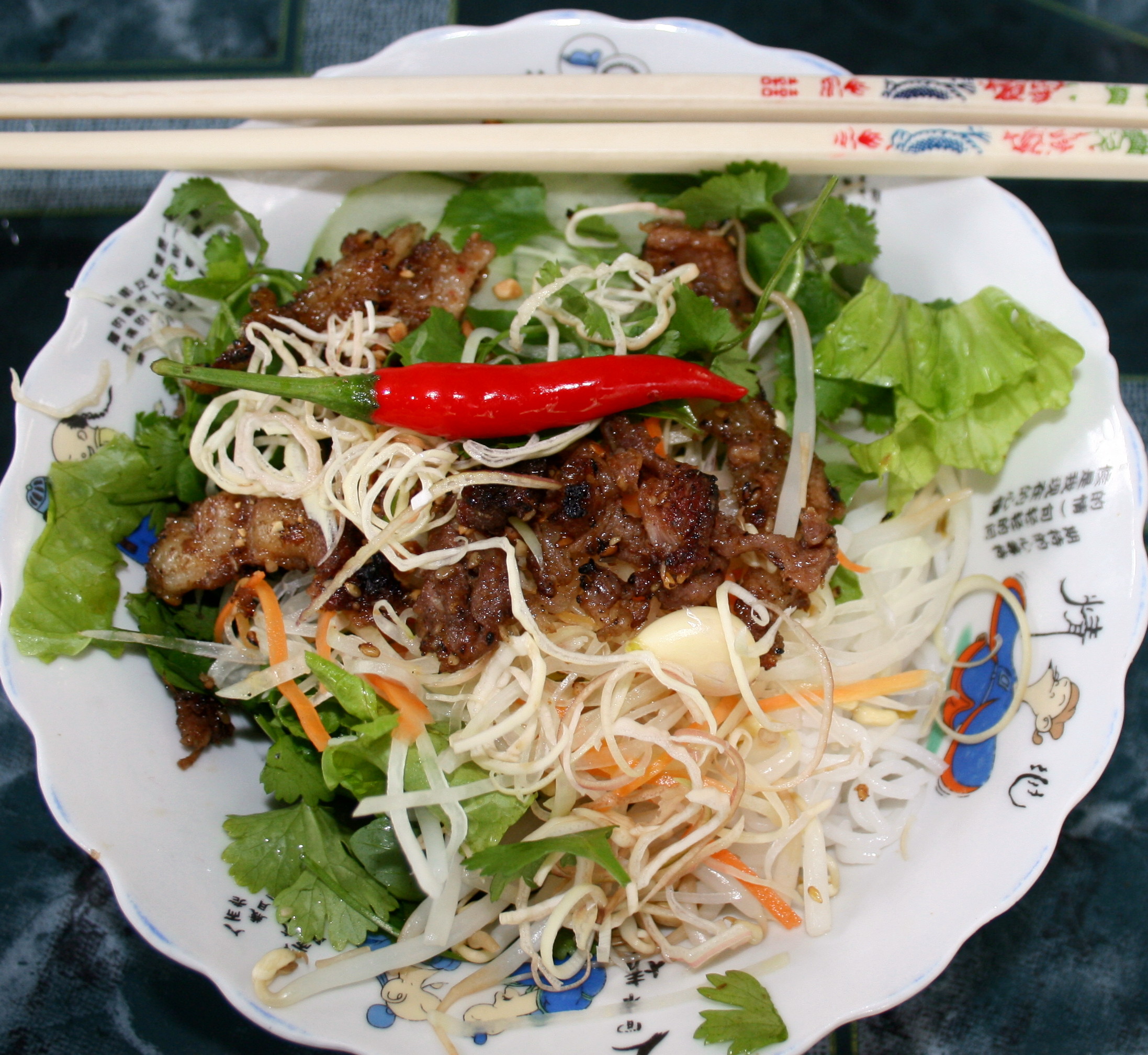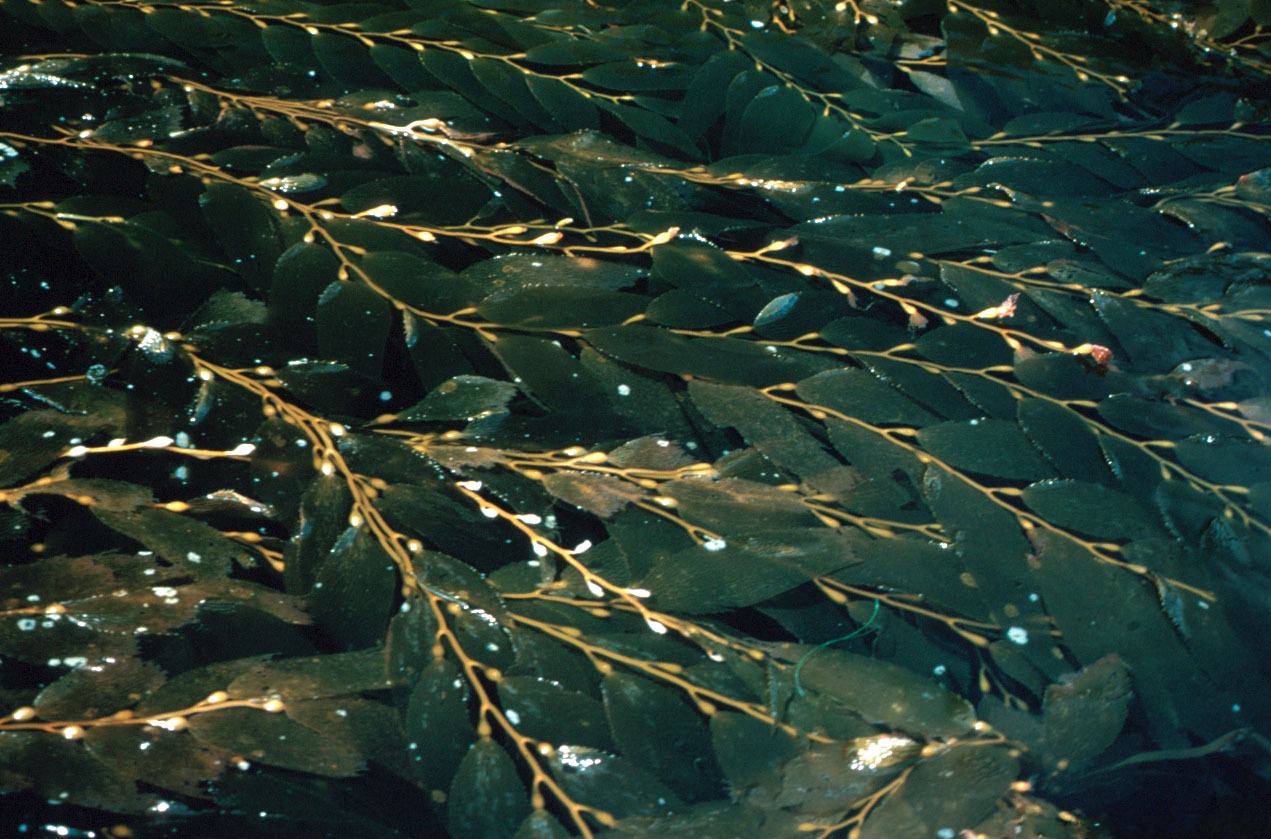|
Cheonsachae
Kelp noodles or cheon sa chae (), are semi-transparent noodles made from the jelly-like extract left after steaming edible kelp. They are made without the addition of grain flour or starch. Kelp noodles have a crunchy texture and are low in calories. They can be eaten raw, in salads, but for added taste, some prefer to cook them in water with spices added for flavoring. Many restaurants serve kelp noodles in stir fry dishes. The noodles usually require rinsing before being added to a stir fry dish towards the end of cooking time. Nutrition Along with their low caloric content, kelp noodles also contain minimal nutrients. Dishes Kelp noodles are mostly prepared in various Asian cuisine as a low-carbohydrate substitute for rice and pasta. They are commonly used in soups, salads, stir-fries and vegetable side dishes. Since they have a neutral taste they take on the flavors of the dishes to which they are added. The noodles can be purchased online or in health food supermarkets, and ... [...More Info...] [...Related Items...] OR: [Wikipedia] [Google] [Baidu] [Amazon] |
East Asia
East Asia is a geocultural region of Asia. It includes China, Japan, Mongolia, North Korea, South Korea, and Taiwan, plus two special administrative regions of China, Hong Kong and Macau. The economies of Economy of China, China, Economy of Japan, Japan, Economy of South Korea, South Korea, and Economy of Taiwan, Taiwan are among the world's largest and most prosperous. East Asia borders North Asia to the north, Southeast Asia to the south, South Asia to the southwest, and Central Asia to the west. To its east is the Pacific Ocean. East Asia, especially History of China, Chinese civilization, is regarded as one of the earliest Cradle of civilization#China, cradles of civilization. Other ancient civilizations in East Asia that still exist as independent countries in the present day include the History of Japan, Japanese, History of Korea, Korean, and History of Mongolia, Mongolian civilizations. Various other civilizations existed as independent polities in East Asia in the past ... [...More Info...] [...Related Items...] OR: [Wikipedia] [Google] [Baidu] [Amazon] |
Noodle
Noodles are a type of food made from unleavened dough which is either rolled flat and cut, stretched, or extruded, into long strips or strings. Noodles are a staple food in many cultures and made into a variety of shapes. The most common noodles are those derived from either Chinese cuisine or Italian cuisine. Chinese noodles are known by a variety of different names, while Italian noodles are known as pasta. While long, thin strips may be the most common, many varieties of noodles are cut into waves, helices, tubes, strings, or shells, or folded over, or cut into other shapes. Noodles are usually cooked in boiling water, sometimes with cooking oil or salt added. They can also be steamed, pan-fried, deep-fried, or baked. Noodles are often served with an accompanying sauce or in a soup, the latter being known as noodle soup. Noodles can be refrigerated for short-term storage or dried and stored for future use. Etymology The word for noodles in English was borrowed in the 1 ... [...More Info...] [...Related Items...] OR: [Wikipedia] [Google] [Baidu] [Amazon] |
Alginic Acid
Alginic acid, also called algin, is a naturally occurring, edible polysaccharide found in brown algae. It is hydrophilic and forms a viscous gum when hydrated. When the alginic acid binds with sodium and calcium ions, the resulting salts are known as alginates. Its colour ranges from white to yellowish-brown. It is sold in filamentous, granular, or powdered forms. It is a significant component of the biofilms produced by the bacterium ''Pseudomonas aeruginosa'', a major pathogen found in the lungs of some people who have cystic fibrosis. The biofilm and ''P. aeruginosa'' have a high resistance to antibiotics, but are susceptible to inhibition by macrophages. Alginate was discovered by British chemical scientist E. C. C. Stanford in 1881, and he patented an extraction process for it in the same year. The alginate was extracted, in the original patent, by first soaking the algae in water or diluted acid, then extracting the alginate by soaking it in sodium carbonate, and finall ... [...More Info...] [...Related Items...] OR: [Wikipedia] [Google] [Baidu] [Amazon] |
Saccharina Japonica
''Saccharina japonica'' is a marine (ocean), marine species of the Phaeophyceae (brown algae) class, a type of kelp or seaweed, which is extensively cultivated on ropes between the seas of China, Japan and Korea. It has the common name sweet kelp. It is widely eaten in East Asia. A commercially important species, ''S. japonica'' is also called ''ma-konbu'' () in Japanese, ''dasima'' () in Korean and ''hǎidài'' () in Chinese. Large harvests are produced by rope cultivation which is a simple method of growing seaweeds by attaching them to floating ropes in the ocean. The species has been cultivated in China, Japan, Korea, Russia and France. It is one of the two most consumed species of kelp in China and Japan. ''Saccharina japonica'' is also used for the production of alginates, with China producing up to ten thousand tons of the product each year. ''S. japonica'' contains very high amounts of Iodine in biology, iodine. Excessive consumption (15 g/day, containing 35 m ... [...More Info...] [...Related Items...] OR: [Wikipedia] [Google] [Baidu] [Amazon] |
Kombu
''Konbu'' (from ) is edible kelp mostly from the family Laminariaceae and is widely eaten in East Asia. It may also be referred to as ''dasima'' () or ''haidai'' (). Kelp features in the diets of many civilizations, including Chinese and Icelandic; however, the largest consumers of kelp are the Japanese, who have incorporated kelp and seaweed into their diets for over 1,500 years. Prominent species There are about eighteen edible species in Laminariaceae and most of them, but not all, are called kombu. Confusingly, species of Laminariaceae have multiple names in biology and in fisheries science. In the following list, fisheries science synonyms are in parentheses, and Japanese names follow them. * ''Saccharina japonica'' (''Laminaria japonica''), ** ''Saccharina japonica'' var. ''religiosa'' (''Laminaria religiosa''), ** ''Saccharina japonica'' var. ''diabolica'' (''Laminaria diabolica''), l ** ''Saccharina japonica'' var. ''ochotensis'' (''Laminaria ochotensis''), – co ... [...More Info...] [...Related Items...] OR: [Wikipedia] [Google] [Baidu] [Amazon] |
Doosan Encyclopedia
''Doosan Encyclopedia'' () is a Korean-language encyclopedia published by Doosan Donga (). The encyclopedia is based on the ''Dong-A Color Encyclopedia'' (), which comprises 30 volumes and began to be published in 1982 by Dong-A Publishing (). Dong-A Publishing was merged into Doosan Donga, a subsidiary of Doosan Group, in February 1985. The ''Doosan Encyclopedia'' is a major encyclopedia in South Korea. Digital edition EnCyber The online version of the ''Doosan Encyclopedia'' was named EnCyber, which is a blend of two English words: ''Encyclopedia'' and ''Cyber''. The company has stated that, with the trademark, it aims to become a center of living knowledge. EnCyber provides free content to readers via South Korean portals such as Naver. Naver has risen to the top position in the search engine market of South Korea partially because of the popularity of EnCyber encyclopedia. When Naver exclusively contracted Doosan Doonga in 2003, the former paid multi billion won to the ... [...More Info...] [...Related Items...] OR: [Wikipedia] [Google] [Baidu] [Amazon] |
Boston Globe
''The Boston Globe,'' also known locally as ''the Globe'', is an American daily newspaper founded and based in Boston, Massachusetts. The newspaper has won a total of 27 Pulitzer Prizes. ''The Boston Globe'' is the oldest and largest daily newspaper in Boston and tenth-largest newspaper by print circulation in the nation as of 2023. Founded in 1872, the paper was mainly controlled by Irish Catholic interests before being sold to Charles H. Taylor and his family. After being privately held until 1973, it was sold to ''The New York Times'' in 1993 for $1.1billion, making it one of the most expensive print purchases in United States history. The newspaper was purchased in 2013 by Boston Red Sox and Liverpool F.C. owner John W. Henry for $70million from The New York Times Company, having lost over 90% of its value in 20 years. The chief print rival of ''The Boston Globe'' is the ''Boston Herald'', whose circulation is smaller and is shrinking faster. The newspaper is "one of ... [...More Info...] [...Related Items...] OR: [Wikipedia] [Google] [Baidu] [Amazon] |
Chinese Noodles
Chinese noodles vary widely according to the region of production, ingredients, shape or width, and manner of preparation. Noodles were invented in China, and are an essential ingredient and Staple food, staple in Chinese cuisine. They are an important part of most regional cuisines within China, and other countries with sizable overseas Chinese populations. Chinese noodles can be made of wheat, buckwheat, rice, millet, maize, oats, Acorn, acorns, kudzu, Ulmus pumila, Siberian elm, soybeans, mung beans, Yam (vegetable), yams, cassava, potatoes, sweet potatoes, and meats such as fish as food, fish and shrimp and prawn as food, shrimp. There are over 1,200 types of noodles commonly consumed in China today, with tens of thousands of noodle dish varieties prepared using these types of noodles. Chinese noodles have entered the cuisines of neighboring East Asian countries such as Korea, Japan, and Mongolia, as well as Southeast Asian countries such as Malaysia, Singapore, Indonesia, V ... [...More Info...] [...Related Items...] OR: [Wikipedia] [Google] [Baidu] [Amazon] |
East Asian Cuisine
This is a list of Asian cuisines, by region. A cuisine is a characteristic style of cooking practices and traditions, usually associated with a specific culture or region. Asia, being the largest, most populous and culturally diverse continent, has a great diversity of cuisines associated with its different regions. Central Asian cuisine * Central Asian cuisine includes food from Kazakhstan, Kyrgyzstan, Tajikistan, Turkmenistan and Uzbekistan. ** Bukharan Jewish cuisine – cuisine of the Bukharan Jews with great influence from Uzbek cuisine. ** Kazakh cuisine – cuisine of Kazakhstan. Traditional Kazakh cuisine revolves around mutton and horse meat, as well as various milk products. For hundreds of years, Kazakhs were herders who raised fat-tailed sheep, Bactrian camels, and horses, relying on these animals for transportation, clothing, and food. *** Kazakh wine ** Koryo-saram cuisine – cuisine of the Koryo-saram, descended from Korean cuisine and influenced by t ... [...More Info...] [...Related Items...] OR: [Wikipedia] [Google] [Baidu] [Amazon] |
Korean Noodles
Korean noodles are noodles or noodle dishes in Korean cuisine, and are collectively referred to as ''guksu'' in Korean language, native Korean or ''myeon'' in hanja character. The earliest noodles in Asia originate from China, and date back 4,000 years ago. In Korea, traditional noodle dishes are ''onmyeon'' (beef broth-based noodle soup), called ''guksu jangguk'' (noodles with a hot clear broth), ''naengmyeon'' (cold buckwheat noodles), ''bibim guksu'' (cold noodle dish mixed with vegetables), ''kalguksu'' (knife-cut noodles), ''kongguksu'' (noodles with a cold soybean broth) among others. In royal court, ''baekmyeon'' (literally "white noodles") consisting of buckwheat noodles and pheasant broth, was regarded as the top quality noodle dish. ''Naengmyeon'', with a cold soup mixed with dongchimi (watery Korean radish, radish kimchi) and beef brisk broth, was eaten in court during summer. Noodles by ingredients * Cellophane noodles, Dangmyeon (당면; cellophane noodles) - made fr ... [...More Info...] [...Related Items...] OR: [Wikipedia] [Google] [Baidu] [Amazon] |





